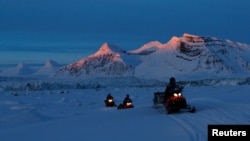Member states at the U.N.'s World Meteorological Organization are concerned about the impacts of melting ice on sea levels, natural disasters, ecosystems and economies.
"The cryosphere issue is a hot topic not just for the Arctic and Antarctic, but it is a global issue," said WMO chief Petteri Taalas.
The melting of glaciers and the Greenland and Antarctica ice sheets account for about 50 percent of sea level rise, which is accelerating. This will have growing impacts on small island developing states and densely-populated coastal areas, says the WMO.
Nations far from the polar regions, such as in the Caribbean and Africa, voiced concerns that changes in the cryosphere would affect the whole planet.
"What happens in polar regions and high mountain regions doesn't stay in those regions," WMO spokeswoman Clare Nullis told reporters.
"More than a billion people rely on water from snow and glaciers melt which is carried by the major rivers of the world. When those glaciers retreat... you need to think what's going to happen to the water security of those people," she said.
Sea ice in Antarctica dropped to 1.92 million square kilometers in February - the lowest level on record and almost one million square kilometers below the 1991-2020 mean.
Meanwhile, the Arctic permafrost is considered a "sleeping giant" of greenhouse gases, said Nullis, as it stores twice as much carbon as is in the atmosphere today.
The world's top meteorologists are meeting in Geneva for the WMO's congress, the quadrennial meeting of member states that sets the U.N. agency's direction and priorities for the next four years.
The congress approved a new Global Greenhouse Gas Watch monitoring initiative to fill critical information gaps and provide an integrated framework for space- and surface-based observations.
"Greenhouse gas concentrations are at record levels - in fact higher than at any time over the last 800,000 years," said Taalas.
Besides implementing the 2015 Paris climate accords and reducing greenhouse gas emissions, the WMO said better monitoring was needed to track the scale and speed of change.
"You cannot manage what you're not measuring," said Nullis.
"And we really need to think hard about water resource management."-











Forum